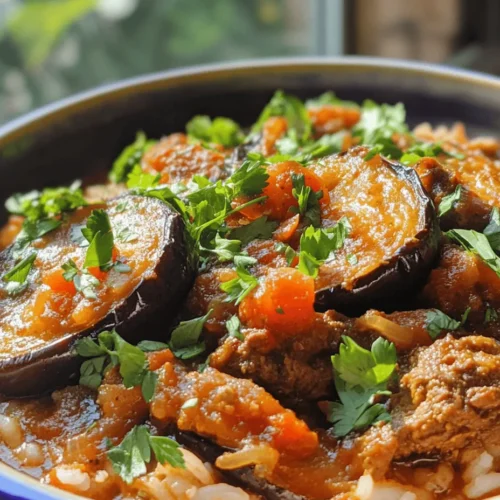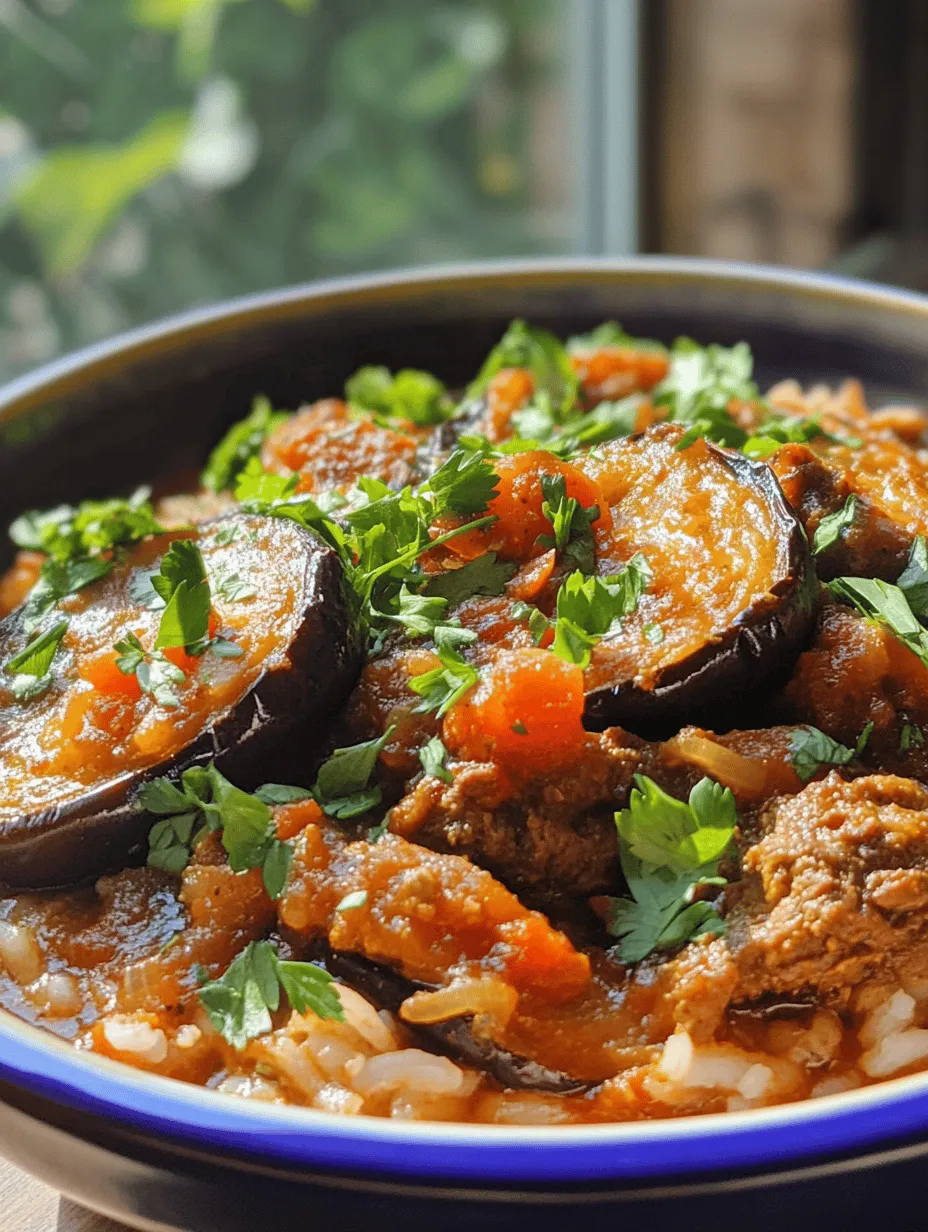Introduction
Khoresh Bademjan is a beloved traditional Persian dish that has won the hearts of many with its rich flavors and comforting nature. This authentic eggplant stew, often served over a bed of fluffy basmati rice, brings together tender meat and luscious eggplants in a savory sauce that is both hearty and satisfying. As one of the many khoresh dishes in Persian cuisine, Khoresh Bademjan showcases the versatility of ingredients and the complexity of flavors that define Iranian culinary traditions.
Eggplant holds a special place in Persian gastronomy. Its unique flavor profile, which becomes beautifully enhanced when cooked, makes it an indispensable component of many Persian dishes. The soft, creamy texture of well-cooked eggplant pairs perfectly with the tender meat and aromatic spices, resulting in a dish that is not only delightful to the palate but also visually appealing. The combination of these ingredients makes Khoresh Bademjan an ideal centerpiece for family gatherings, celebrations, and everyday meals alike.
Understanding Khoresh Bademjan
Khoresh Bademjan is more than just a dish; it is a representation of Persian culture and history. Stews, or khoresh, have been an integral part of Persian meals for centuries, often served at gatherings and special occasions. Each region of Iran has its own variation of khoresh, highlighting local ingredients and culinary techniques. Khoresh Bademjan, with its origins rooted in the southeastern provinces of Iran, particularly Kerman and Yazd, reflects the agricultural abundance of the area, where eggplants thrive in the warm climate.
Historically, this dish has been a staple in Persian households, symbolizing hospitality and warmth. Traditionally, it is prepared slowly, allowing the flavors to meld and develop over time. This method of cooking not only enhances the taste but also the nutritional value of the dish, making it a wholesome meal. The primary ingredients—eggplants, beef or lamb, and a blend of spices—offer a range of health benefits. Eggplants are low in calories yet high in fiber, providing a sense of fullness while delivering essential vitamins and minerals. The addition of meat contributes protein, iron, and other vital nutrients, making Khoresh Bademjan a balanced dish.
Key Ingredients Explained
Eggplants
The star of Khoresh Bademjan is undoubtedly the eggplant. In Persian cuisine, the most common variety used is the globe eggplant, known for its smooth skin and mild flavor. However, other varieties like the slender Japanese eggplant can also be used, providing a slightly different texture. When choosing eggplants, look for ones that are firm and glossy, indicating freshness.
The preparation of eggplants is crucial for achieving the perfect stew. Before cooking, many recipes recommend salting the eggplant slices to draw out excess moisture and bitterness. This process not only enhances the flavor but also helps achieve a desirable texture when the eggplants are fried. Once properly prepared, eggplants contribute a creamy, melt-in-your-mouth quality to the stew that balances beautifully with the robust flavors of the meat and spices.
Meat Options
When it comes to the meat for Khoresh Bademjan, both beef and lamb are popular choices, each bringing its own unique flavor to the dish. Beef is often preferred for its richness and deep flavor, while lamb offers a slightly gamier taste that some find irresistible. The cooking time for these meats can vary, with lamb usually requiring less time to become tender. Regardless of the choice, the key is to select good quality meat, preferably from a trusted butcher, to ensure the best flavor and texture in the finished dish.
Spices
The spices used in Khoresh Bademjan are what truly elevate the dish, creating layers of flavor that delight the senses. Turmeric is a foundational spice in Persian cooking, known for its vibrant color and earthy taste. It also offers numerous health benefits, including anti-inflammatory properties. Cinnamon, often associated with sweet dishes, is used here to add warmth and depth to the stew. Lastly, cumin brings a nutty, aromatic flavor that complements the other spices beautifully.
In addition to these spices, Khoresh Bademjan may also include black pepper and sometimes saffron, which adds a luxurious touch to the dish. Fresh herbs, such as parsley and cilantro, are often used as a garnish, adding a burst of color and freshness that brightens the overall flavor profile.
Preparation Techniques
Steps to Prepare Eggplants Effectively
The preparation of eggplants is one of the most critical steps in making Khoresh Bademjan. Begin by slicing the eggplants into thick rounds or long strips, depending on your preference. After slicing, sprinkle salt generously over the pieces and let them sit for 30 to 60 minutes. This salting process draws out moisture and bitterness, resulting in a more flavorful and enjoyable dish.
After salting, rinse the eggplants under cold water to remove excess salt and pat them dry with paper towels. This step is essential to ensure that the eggplants fry properly without becoming soggy. The next step is frying the eggplants until they are golden brown and crispy on the outside. This can be done in a skillet with a generous amount of oil, which helps enhance the flavor and texture. Frying the eggplants until they are caramelized adds a depth of flavor that is crucial for the stew.
Sautéing Onions: The Foundation of Flavor in Khoresh Bademjan
While the eggplants are being prepared, the next step is to sauté the onions. Onions are the aromatic base of many Persian stews, and they play a significant role in developing the dish’s flavor. Start by finely chopping one or two large onions and heating oil in a pot over medium heat. Add the onions to the pot and sauté them until they become translucent and golden brown.
This caramelization process releases the natural sugars in the onions, providing a sweet undertone that balances the richness of the meat and eggplants. Once the onions are perfectly sautéed, it’s time to add the meat and spices, allowing the flavors to meld together beautifully.
By mastering these preparation techniques, you set the stage for creating a delicious Khoresh Bademjan that your family and friends will love. The careful handling of eggplants and the foundational flavors provided by sautéed onions are essential steps toward achieving the authentic taste of this comforting Persian stew.

Browning Meat: Techniques to Lock in Juices and Enhance Flavor
Browning meat is a crucial step in making Khoresh Bademjan as it not only enhances the flavor of the dish but also helps to lock in the juices, ensuring that the meat remains tender. To achieve the perfect browning, start with a heavy-bottomed pot or Dutch oven. Heating the pot properly is vital; ensure it is hot enough before adding oil. Use a high smoke point oil, such as vegetable or canola oil, to allow for proper searing.
When adding the meat, avoid overcrowding the pot, as this can cause the meat to steam rather than brown. Instead, work in batches if necessary. Allow the meat to sear undisturbed for several minutes before flipping, which will create a nice crust. This caramelization adds depth of flavor to your stew.
Cooking Instructions
Step-by-Step Cooking Process:
1. Sautéing Onions and Garlic for Optimal Flavor:
Once your meat is browned and set aside, the next step is to build the flavor base for Khoresh Bademjan by sautéing onions. Use the same pot to retain all the browned bits stuck to the bottom, which are packed with flavor. Add finely chopped onions and cook them over medium heat until they become translucent and slightly caramelized. This could take about 7-10 minutes. Stir occasionally to avoid burning. Once the onions are softened, add minced garlic and sauté for an additional minute until fragrant.
2. Layering Flavors with Spices and Tomatoes:
Now it’s time to introduce spices that define Khoresh Bademjan. Add turmeric, cinnamon, and black pepper to the onion and garlic mixture, stirring to coat the onions and toast the spices for about 30 seconds. This process releases the essential oils in the spices, enhancing their flavor. Next, add tomato paste, which will add richness to the stew. Cook this mixture for a few minutes, allowing the tomato paste to caramelize slightly before adding diced tomatoes or tomato puree. This layering of flavors is essential for a rich and complex stew.
3. The Simmering Process:
After the tomato mixture has cooked down, return the browned meat to the pot along with any juices it has released. Pour in enough water or broth to cover the meat. Bring the mixture to a boil, then reduce the heat to low. Cover the pot and let it simmer gently for about 1.5 to 2 hours. This long cooking time allows the meat to become tender and for the flavors to meld beautifully. Stir occasionally and check to make sure there is enough liquid in the pot.
4. Incorporating Fried Eggplants:
While the stew is simmering, prepare the eggplants. Slice them into thick rounds and sprinkle with salt. Allow them to sit for about 30 minutes to draw out excess moisture and bitterness. Rinse and pat them dry before frying in hot oil until golden brown on both sides. Once your stew has simmered, gently fold the fried eggplant slices into the pot. Be careful not to break them apart; you want them to maintain their structure and absorb the flavors of the stew without disintegrating.
Serving Suggestions
Traditional Serving Methods for Khoresh Bademjan:
Khoresh Bademjan is traditionally served with steamed Persian rice, known as “chelow.” The fluffy rice acts as a perfect canvas to soak up the rich stew. When plating, use a large spoon to create a mound of rice topped with the stew, allowing the sauce to cascade over the rice. Garnish with fresh herbs, such as parsley or cilantro, for a pop of color and freshness.
The Importance of Persian Rice:
When it comes to Persian rice, the most commonly used varieties are Basmati or Jasmine. Basmati rice is preferred for its long grains and fragrant aroma. To prepare perfect rice, rinse it several times until the water runs clear to remove excess starch, which helps achieve fluffy grains. Soak the rice in water for at least 30 minutes before cooking. Bring salted water to a boil, add the soaked rice, and cook until just tender. Drain and steam the rice in a covered pot for about 20 minutes to achieve the desired fluffy texture.
Suggested Side Dishes or Accompaniments:
Khoresh Bademjan pairs beautifully with several side dishes that enhance the meal. A fresh salad Shirazi, made with diced cucumber, tomatoes, and onions dressed in lemon juice and olive oil, provides a refreshing contrast. Additionally, a side of thick yogurt or mast, seasoned with mint and garlic, complements the richness of the stew and adds a cooling element to the dish.
Variations of Khoresh Bademjan
Regional Variations and Personal Twists:
Khoresh Bademjan can vary from region to region in Iran. Some variations include the addition of split peas or lentils for a heartier stew, while others may incorporate different spices such as saffron or cardamom for a unique twist. Feel free to experiment with your own personal touches to make the recipe your own.
Vegetarian Adaptations:
For those seeking a vegetarian version of Khoresh Bademjan, consider substituting the meat with protein-rich alternatives such as chickpeas, lentils, or even tofu. These ingredients not only provide protein but also absorb the flavors of the stew beautifully. Use the same techniques as the original recipe, ensuring to sauté the chickpeas or lentils in the spice mixture to infuse flavor before adding the tomatoes and liquids.
Seasonal Vegetable Additions:
You can also enhance the nutritional value and flavor profile of Khoresh Bademjan by adding seasonal vegetables. Zucchini, bell peppers, or carrots can be added alongside the eggplants, contributing additional textures and flavors to the dish. Always ensure that these vegetables are cut into larger pieces to maintain their integrity throughout the cooking process.
Pairing and Beverage Suggestions
Recommended Persian Drinks:
To complement Khoresh Bademjan, consider serving traditional Persian drinks such as Doogh, a refreshing yogurt drink blended with mint, or a simple glass of Persian tea. The acidity and slight effervescence of Doogh help balance the richness of the stew, while tea can enhance the enjoyment of the meal.
Exploring Side Dishes:
In addition to salad Shirazi, consider serving Khoresh Bademjan with a side of saffron-infused rice pilaf or a simple cucumber and tomato salad. These side dishes provide a refreshing counterpoint to the rich and savory stew, creating a well-rounded meal experience.
Conclusion
Khoresh Bademjan is more than just a dish; it’s a celebration of Iranian culinary tradition, rich in flavors and history. With its tender meat, luscious eggplants, and aromatic spices, this Persian eggplant stew serves as a reminder of the warmth and hospitality that defines Persian culture. By exploring this recipe, you not only engage with the intricate flavors of Persian cuisine but also create an opportunity to share these culinary traditions with your loved ones. Embrace the process, savor the aromas, and enjoy the delightful experience of cooking Khoresh Bademjan.



